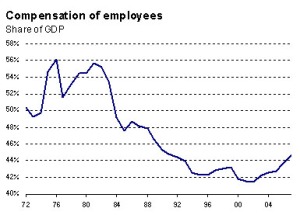As I said, I will discuss the RBNZ speech from yesterday.
Personally, I thought the speech was spot on – Dr Bollard understands the issues associated with inflation targeting, but he also more than understands the benefits.
Look at this statement surrounding oil prices shocks:
Instead, the key policy requirement in this situation is to allow the initial externally driven relative price changes to occur, but keep monetary policy sufficiently firm to ensure that generalised second-round inflation effects do not take hold – in other words, to keep inflation expectations anchored.
This is all I wanted the Bank to say in their latest statement – that they would react to the second round of price increases stemming from an increase in oil prices if it occurs. Tell the market that, although the CPI figure looks bad, once we’ve cleared the recent shocks inflation will again be the primary concern.
Furthermore, the Bank damned alternatives to inflation targeting – specifically:
Another alternative that could appear superficially attractive is to require monetary policy to target multiple objectives such as growth, employment, export and the balance of payments. This was the approach taken in New Zealand and many other countries in the post-war period up to the early 1980s. It inevitably had a short-term focus, and resulted in stop-go policies and high inflation. We now know that one instrument cannot succeed in achieving multiple objectives over the cycle. The move to inflation targeting, with its single, clear objective, resulted from the lessons learned in that period. We do not want to re-learn those lessons.
Very good 🙂
Read more

